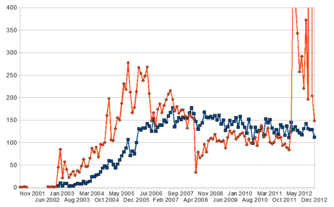An online community, also called an internet community or web community, is a community whose members interact with each other primarily via the Internet. Members of the community usually share common interests. For many, online communities may feel like home, consisting of a "family of invisible friends". Additionally, these "friends" can be connected through gaming communities and gaming companies. Those who wish to be a part of an online community usually have to become a member via a specific site and thereby gain access to specific content or links.
Personalization consists of tailoring a service or product to accommodate specific individuals, sometimes tied to groups or segments of individuals. Personalization requires collecting data on individuals, including web browsing history, web cookies, and location. Companies and organizations use personalization to improve customer satisfaction, digital sales conversion, marketing results, branding, and improved website metrics as well as for advertising. Personalization is a key element in social media and recommender systems. Personalization affects every sector of society—work, leisure, and citizenship.
Sustainability reporting refers to the disclosure, whether voluntary, solicited, or required, of non-financial performance information to outsiders of the organization. Generally speaking, sustainability reporting deals with information concerning environmental, social, economic and governance issues in the broadest sense. These are the criteria gathered under the acronym ESG.
Predictive analytics is a form of business analytics applying machine learning to generate a predictive model for certain business applications. As such, it encompasses a variety of statistical techniques from predictive modeling and machine learning that analyze current and historical facts to make predictions about future or otherwise unknown events. It represents a major subset of machine learning applications; in some contexts, it is synonymous with machine learning.

Social media are interactive technologies that facilitate the creation, sharing and aggregation of content, ideas, interests, and other forms of expression through virtual communities and networks. Social media refers to new forms of media that involve interactive participation. While challenges to the definition of social media arise due to the variety of stand-alone and built-in social media services currently available, there are some common features:
- Social media are interactive Web 2.0 Internet-based applications.
- User-generated content—such as text posts or comments, digital photos or videos, and data generated through all online interactions—is the lifeblood of social media.
- Users create service-specific profiles for the website or app that are designed and maintained by the social media organization.
- Social media helps the development of online social networks by connecting a user's profile with those of other individuals or groups.

Digital marketing is the component of marketing that uses the Internet and online-based digital technologies such as desktop computers, mobile phones, and other digital media and platforms to promote products and services. Its development during the 1990s and 2000s changed the way brands and businesses use technology for marketing. As digital platforms became increasingly incorporated into marketing plans and everyday life, and as people increasingly used digital devices instead of visiting physical shops, digital marketing campaigns have become prevalent, employing combinations of search engine optimization (SEO), search engine marketing (SEM), content marketing, influencer marketing, content automation, campaign marketing, data-driven marketing, e-commerce marketing, social media marketing, social media optimization, e-mail direct marketing, display advertising, e-books, and optical disks and games have become commonplace. Digital marketing extends to non-Internet channels that provide digital media, such as television, mobile phones, callbacks, and on-hold mobile ringtones. The extension to non-Internet channels differentiates digital marketing from online marketing.
Customer engagement is an interaction between an external consumer/customer and an organization through various online or offline channels. According to Hollebeek, Srivastava and Chen S-D logic-Definition of customer engagement is "a customer’s motivationally driven, volitional investment of operant resources, and operand resources into brand interactions," which applies to online and offline engagement.
A click path or clickstream is the sequence of hyperlinks one or more website visitors follows on a given site, presented in the order viewed. A visitor's click path may start within the website or at a separate third party website, often a search engine results page, and it continues as a sequence of successive webpages visited by the user. Click paths take call data and can match it to ad sources, keywords, and/or referring domains, in order to capture data.
Social media measurement, also called social media controlling, is the management practice of evaluating successful social media communications of brands, companies, or other organizations.

Social media marketing is the use of social media platforms and websites to promote a product or service. Although the terms e-marketing and digital marketing are still dominant in academia, social media marketing is becoming more popular for both practitioners and researchers. Most social media platforms have built-in data analytics tools, enabling companies to track the progress, success, and engagement of social media marketing campaigns. Companies address a range of stakeholders through social media marketing, including current and potential customers, current and potential employees, journalists, bloggers, and the general public. On a strategic level, social media marketing includes the management of a marketing campaign, governance, setting the scope and the establishment of a firm's desired social media "culture" and "tone".
Fraud represents a significant problem for governments and businesses and specialized analysis techniques for discovering fraud using them are required. Some of these methods include knowledge discovery in databases (KDD), data mining, machine learning and statistics. They offer applicable and successful solutions in different areas of electronic fraud crimes.
Learning analytics is the measurement, collection, analysis and reporting of data about learners and their contexts, for purposes of understanding and optimizing learning and the environments in which it occurs. The growth of online learning since the 1990s, particularly in higher education, has contributed to the advancement of Learning Analytics as student data can be captured and made available for analysis. When learners use an LMS, social media, or similar online tools, their clicks, navigation patterns, time on task, social networks, information flow, and concept development through discussions can be tracked. The rapid development of massive open online courses (MOOCs) offers additional data for researchers to evaluate teaching and learning in online environments.
A digital marketing system (DMS) is a method of centralized channel distribution used primarily by SaaS products. It combines a content management system (CMS) with data centralization and syndication across the web, mobile, scannable surface, and social channels.

Voluntary disclosure is the provision of information by a company's management beyond requirements such as generally accepted accounting principles and Securities and Exchange Commission rules, where the information is believed to be relevant to the decision-making of users of the company's annual reports.

A user profile is a collection of settings and information associated with a user. It contains critical information that is used to identify an individual, such as their name, age, portrait photograph and individual characteristics such as knowledge or expertise. User profiles are most commonly present on social media websites such as Facebook, Instagram, and LinkedIn; and serve as voluntary digital identity of an individual, highlighting their key features and traits. In personal computing and operating systems, user profiles serve to categorise files, settings, and documents by individual user environments, known as ‘accounts’, allowing the operating system to be more friendly and catered to the user. Physical user profiles serve as identity documents such as passports, driving licenses and legal documents that are used to identify an individual under the legal system.

In scholarly and scientific publishing, altmetrics are non-traditional bibliometrics proposed as an alternative or complement to more traditional citation impact metrics, such as impact factor and h-index. The term altmetrics was proposed in 2010, as a generalization of article level metrics, and has its roots in the #altmetrics hashtag. Although altmetrics are often thought of as metrics about articles, they can be applied to people, journals, books, data sets, presentations, videos, source code repositories, web pages, etc.
ResearchGate is a European commercial social networking site for scientists and researchers to share papers, ask and answer questions, and find collaborators. According to a 2014 study by Nature and a 2016 article in Times Higher Education, it is the largest academic social network in terms of active users, although other services have more registered users, and a 2015–2016 survey suggests that almost as many academics have Google Scholar profiles.
Behavioral analytics is a recent advancement in business analytics that reveals new insights into the behavior of consumers on eCommerce platforms, online games, web and mobile applications, and Internet of Things (IoT). The rapid increase in the volume of raw event data generated by the digital world enables methods that go beyond demographics and other traditional metrics that tell us what kind of people took what actions in the past. Behavioral analysis focuses on understanding how consumers act and why, enabling predictions about how they are likely to act in the future. It enables marketers to make the right offers to consumer segments at the right time.
Social media reach is a media analytics metric that refers to the number of users who have come across a particular content on a social platform such as Facebook, Instagram or Twitter. Social media platforms including Facebook, Twitter, YouTube, Instagram, Spotify and many more have their own individual ways of tracking, analyzing and reporting the traffic on each of the individual platforms. Each platform allows their users, from everyday citizens to public figures and companies, to create posts and content, to be active on the platform and to interact with other users. These platforms are also a main source of communication between companies and their target audiences. By conducting research, companies are able to utilize analytical information, such as the reach of their posts, to better understand the interactions between the users and their content.
Artificial intelligence is used by many different businesses and organizations. It is widely used in the financial sector, especially by accounting firms, to help detect fraud.







